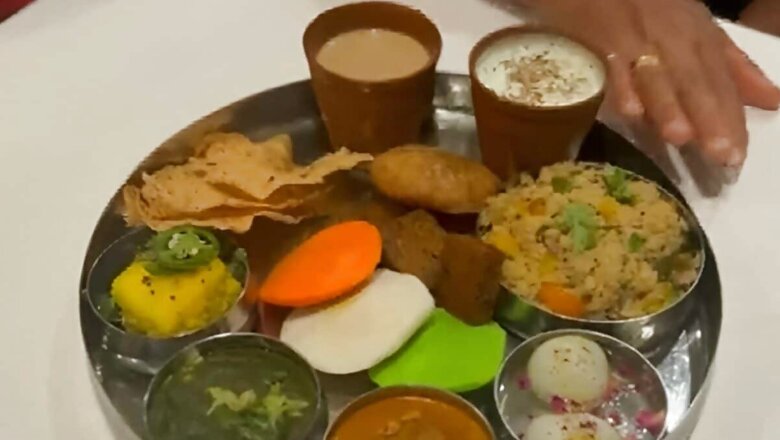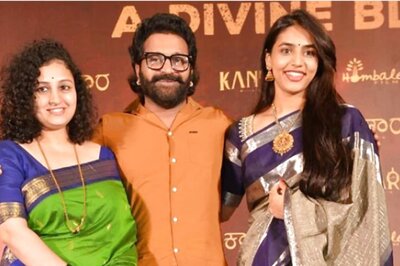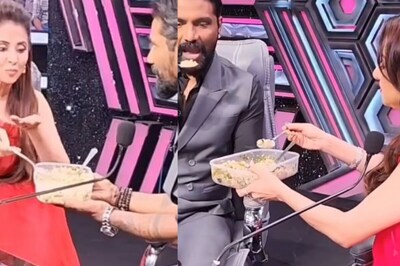
views
Ahead of Prime Minister Narendra Modi’s state visit to the US, a ‘Modiji Thali’ was launched this week at New Jersey’s Mehek restaurant; curated by its owner-chef Shripad Kulkarni, it features among other vegetarian delights khichdi, sarson da saag, kothimbir vadi, dhokla and Kashmiri dum aloo. A ‘Jaishankar Thali’ may be added soon. Meanwhile, chef Srijith Gopinathan’s ‘Copra’ topped the Robb Report’s list of the 10 best new restaurants in the US, which also released this week.
These two events bookend the fact that Indian cuisine is finally coming into its own in the US, forming the perfect backdrop for the prime minister’s landmark visit. And many eyes will be on the White House state banquet as well as the “private dinner” for him hosted by the Bidens the night before. Earlier at a similar dinner in the White House in 2014 with then President Barack Obama, Prime Minister Modi only had lukewarm lime water because it happened to be Navratri.
It was rumoured that the Obamas were planning an all-vegetarian meal but as he was fasting, they added the crisped halibut with ginger carrot juice alongside the saffron basmati rice and goat cheese and baby bell peppers for the other diners. Nine years later, much has changed in the US and India, and our cuisine has certainly risen in profile since, giving the Filipino-American White House executive chef Cristeta Comerford plenty of food for thought.
A glance at the White House menus since the first ever visit by an Indian PM — Jawaharlal Nehru in 1949 — shows that the US is more mindful now than before about the palates of foreign leaders. Back then, President Harry S Truman’s chef had actually decided on oxtail soup for the state dinner. Luckily, the faux pas was averted but only at the 11th hour as the typed menu in the presidential records shows ‘Soup Juliene’ (sic) written by hand, crossing out the bovine broth!
The White House chroniclers also may not like to remember that during the state dinner for President S Radhakrishnan in 1963, the Kennedys offered a distinctly French menu (as they did for Nehru in 1961) featuring salmon in aspic, followed by roast spring lamb with rice a l’orientale and spinach a la crème, ending with bombe glace aux peches. As even ice creams used egg yolks for richness, what our vegetarian president ate that evening remains unknown.
But White House chefs played it safe thereafter, sticking to fish and fowl, including pheasant breast, for Indira Gandhi’s first visit as PM, though she had attended three other dinners previously as “daughter of the Indian PM”. Curiously, she was served pheasant again when she was hosted by her bete noire Richard Nixon in 1971. The only red meat to feature on White House menus for Indian PMs since the oxtail blunder has been lamb. Lessons have been learnt.
In 2000, for the official dinner that the Clintons hosted for then PM Atal Bihari Vajpayee, the menu included Darjeeling tea smoked poussin (chooza), chilled green pea (matar) and cilantro (dhania) soup, marble potatoes, wild salmon, red kuri squash and rice, bean ragout (lobia), young greens and herb salad and for dessert, “mango and banner lotus, litchis and raspberry sauce” or a mysterious “majestic tiger’s delight”. Attention was clearly turning to Indian palates.
By the time then PM Manmohan Singh was hosted by President George W Bush in 2005, more Indian accents were evident. Not only were the tablecloths made of saffron and gold silk and the chrysanthemum flower arrangements resembled trumpeting elephants, but the fish main course was accompanied by a rice dish that seemed distinctly pulao-like: basmati dotted with pistas and raisins. And the dessert was “Lotus Blossom Mango, Chocolate-Cardamom and Cashew”.
And when Singh went for a second state visit in 2009, the Obamas offered very American-desi fare: potato and eggplant salad (aloo baingan) with onion seed (kalonji) vinaigrette, red lentil (masoor dal) soup with fresh cheese (paneer), aged basmati, potato dumplings (batata vada) with tomato chutney, chickpeas (chana) and okra (bhindi), green curry prawns with smoked collard greens (saag) and coconut, ending with pumpkin (kaddu) tart and cashew brittle (chikki).
Going by this progression, the 2023 menu for PM Modi should be even more Indian, given that the Biden administration’s tally of Indian-American officials is also the highest ever now. And Comerford’s appointment itself was said to have been the result of her excellent handling of the first White House dinner for Singh in 2005. If she can pull off, say, an all-vegetarian meal using elements of both US and Indian culinary traditions, she could start another new trend.
Over the past decade there has been a veritable explosion of high-quality desi cuisine outlets in the US. This has resulted in Michelin stars for Indian restaurants there, including most recently, the south Indian cuisine focused ‘Semma’ in New York. Moreover, Chef Meherwan Irani’s ‘Chai Pani’ café in obscure Asheville, North Carolina, was also declared America’s ‘Most Outstanding Restaurant’ in 2022 by the James Beard Foundation, widely regarded as America’s food Oscars.
And now Gopinathan’s ‘Copra’ in San Francisco and chef Sujan Sarkar’s ‘Indienne’ in Chicago have had dream debuts on the US food scene thanks to their listing in the latest Robb Report. And Indian names in the culinary world are no longer rare, from the late chef Floyd Cardoz, Suvir Saran, Chintan Pandya, Vikas Khanna and many others to restaurateurs like Ashok Bajaj and Roni Mazumdar, TV foodies Aarti Sequeira and Padma Lakshmi, and more.
Yet Indian food still lags behind Chinese and Italian in the US, unlike in the UK where curry colonised the British palate before Indians began to dominate the culinary scene — and now the political arena too. Though big US companies and even the World Bank have Indian-origin bosses, Hollywood has Indian stars, the US vice-president is part Indian and high-quality Indian cuisine is making waves, there is still a way to go before our jalebis rival donuts and chaat takes on tacos.
That is where gastro-diplomacy by PM Modi’s visit can give a fillip to smaller Indian eateries. In May, the PM exhorted the desi diaspora in Sydney to get his Australian counterpart to taste chaat and jalebis. In Washington DC, PM Modi can persuade the Bidens to try desi food, though not necessarily ‘Modiji Thali’. Biden has chatted with Indian restaurateurs before but not tasted the food. He and many Americans already love quesadillas and churros; why not parathas and jalebis next?
(The author is a freelance writer. Views expressed are personal)




















Comments
0 comment